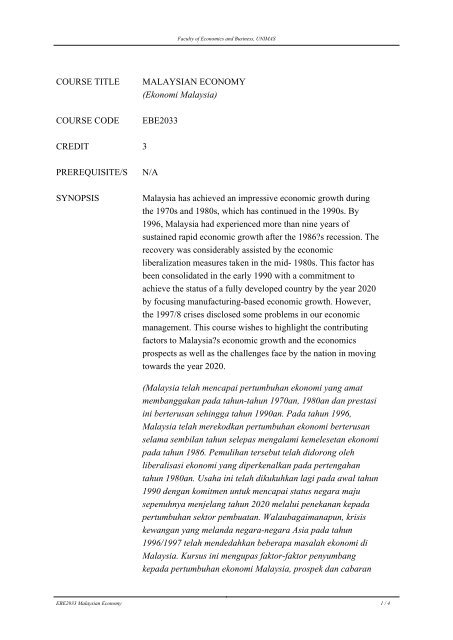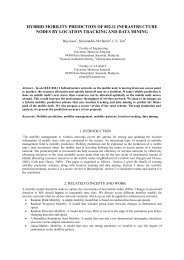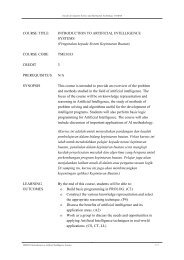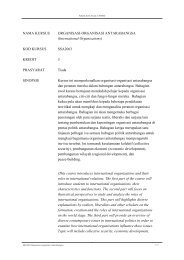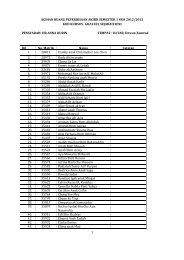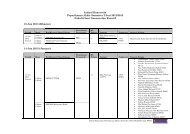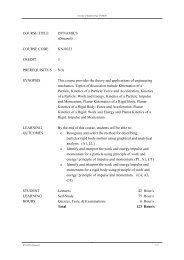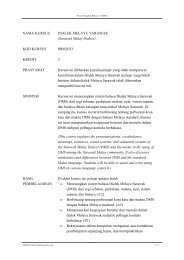COURSE TITLE MALAYSIAN ECONOMY (Ekonomi Malaysia ...
COURSE TITLE MALAYSIAN ECONOMY (Ekonomi Malaysia ...
COURSE TITLE MALAYSIAN ECONOMY (Ekonomi Malaysia ...
Create successful ePaper yourself
Turn your PDF publications into a flip-book with our unique Google optimized e-Paper software.
Faculty of Economics and Business, UNIMAS<br />
<strong>COURSE</strong> <strong>TITLE</strong><br />
<strong>COURSE</strong> CODE<br />
<strong>MALAYSIAN</strong> <strong>ECONOMY</strong><br />
(<strong>Ekonomi</strong> <strong>Malaysia</strong>)<br />
EBE2033<br />
CREDIT 3<br />
PREREQUISITE/S<br />
SYNOPSIS<br />
N/A<br />
<strong>Malaysia</strong> has achieved an impressive economic growth during<br />
the 1970s and 1980s, which has continued in the 1990s. By<br />
1996, <strong>Malaysia</strong> had experienced more than nine years of<br />
sustained rapid economic growth after the 1986s recession. The<br />
recovery was considerably assisted by the economic<br />
liberalization measures taken in the mid- 1980s. This factor has<br />
been consolidated in the early 1990 with a commitment to<br />
achieve the status of a fully developed country by the year 2020<br />
by focusing manufacturing-based economic growth. However,<br />
the 1997/8 crises disclosed some problems in our economic<br />
management. This course wishes to highlight the contributing<br />
factors to <strong>Malaysia</strong>s economic growth and the economics<br />
prospects as well as the challenges face by the nation in moving<br />
towards the year 2020.<br />
(<strong>Malaysia</strong> telah mencapai pertumbuhan ekonomi yang amat<br />
membanggakan pada tahun-tahun 1970an, 1980an dan prestasi<br />
ini berterusan sehingga tahun 1990an. Pada tahun 1996,<br />
<strong>Malaysia</strong> telah merekodkan pertumbuhan ekonomi berterusan<br />
selama sembilan tahun selepas mengalami kemelesetan ekonomi<br />
pada tahun 1986. Pemulihan tersebut telah didorong oleh<br />
liberalisasi ekonomi yang diperkenalkan pada pertengahan<br />
tahun 1980an. Usaha ini telah dikukuhkan lagi pada awal tahun<br />
1990 dengan komitmen untuk mencapai status negara maju<br />
sepenuhnya menjelang tahun 2020 melalui penekanan kepada<br />
pertumbuhan sektor pembuatan. Walaubagaimanapun, krisis<br />
kewangan yang melanda negara-negara Asia pada tahun<br />
1996/1997 telah mendedahkan beberapa masalah ekonomi di<br />
<strong>Malaysia</strong>. Kursus ini mengupas faktor-faktor penyumbang<br />
kepada pertumbuhan ekonomi <strong>Malaysia</strong>, prospek dan cabaran<br />
EBE2033 <strong>Malaysia</strong>n Economy 1 / 4
Faculty of Economics and Business, UNIMAS<br />
yang dihadapi oleh <strong>Malaysia</strong> di dalam usaha menuju ke arah<br />
negara maju menjelang tahun 2020.)<br />
LEARNING<br />
OUTCOMES<br />
By the end of this course, students will be able to:<br />
o list down previous and current economic policies and<br />
socio-economic issues in <strong>Malaysia</strong>, and to relate it with the<br />
performance of <strong>Malaysia</strong>n economy in the past and future.<br />
(C2, P1, A4, CT)<br />
o explain the roles of different economic sectoral and their<br />
importance on the development of <strong>Malaysia</strong>n economy<br />
(C2, P1, A4, CT, TS)<br />
o Relate how ICT development facilitates the achievement of<br />
Vision 2020 (C3, P1, A4, CS, CT)<br />
STUDENT<br />
LEARNING<br />
HOURS<br />
Lectures<br />
Tutorials<br />
Self-Study<br />
Quizzes, Tests, & Examinations<br />
Total<br />
28 Hour/s<br />
10 Hour/s<br />
73 Hour/s<br />
9 Hour/s<br />
120 Hour/s<br />
LEARNING<br />
UNITS<br />
Supervised<br />
Learning Hours<br />
1. LU 1: Introduction<br />
3<br />
a. Background of <strong>Malaysia</strong>n Economy-Analyzing<br />
Macroeconomic indicators<br />
2. b. Highlighting <strong>Malaysia</strong>n economic policies<br />
3<br />
3. LU 2: Structural Development and Performance of<br />
<strong>Malaysia</strong>n Economy<br />
a. Agricultural Sector Development<br />
b. Automotive Industry Development<br />
3<br />
4. c. Telecommunications Sector<br />
3<br />
d. Tourism Industry<br />
5. e. Banking Industry - Merging and consolidation<br />
issues<br />
f. Foreign Direct Investment and economic<br />
development<br />
3<br />
EBE2033 <strong>Malaysia</strong>n Economy 2 / 4
Faculty of Economics and Business, UNIMAS<br />
6. g. Privatization Programme and its impact on<br />
3<br />
economic development in <strong>Malaysia</strong><br />
7. LU 3: Socio Economic Issues in <strong>Malaysia</strong><br />
0<br />
a. Patterns and Trends in Income Distribution,<br />
Employment, Retrenchment and Poverty<br />
8. b. Education and Manpower Development in<br />
0<br />
<strong>Malaysia</strong><br />
9. LU 4: Knowledge-based economy (K Economy)<br />
Development in <strong>Malaysia</strong><br />
a. Knowledge-Based Economy Development<br />
b. Multimedia Super Corridor (MSC) and Vision<br />
2020<br />
0<br />
10. LU 5: Financial Crisis- What is our faults<br />
0<br />
a. Fundamental reassessment.<br />
b. Theoritical views underlying the financial crisis<br />
11. c. Globalization and Its Challenges<br />
0<br />
-WTO and Regional Trade Arrangements<br />
-Impact of globalization on <strong>Malaysia</strong>n Economy<br />
12. LU 6: Optimum Currency Area (OCA) and Currency<br />
Band<br />
-ASEAN Economic Community (AEC)<br />
-Economic Integration-OCA, its benefits and costs<br />
0<br />
13. Currency Band<br />
-Regimes of currency in <strong>Malaysia</strong>: Pegging and<br />
managed float and its implication on the strength of<br />
<strong>Malaysia</strong>n Ringgit<br />
0<br />
14. Revision<br />
0<br />
ASSESSMENT Assignment<br />
30 %<br />
Quiz<br />
5 %<br />
Mid term exam<br />
25 %<br />
final exam<br />
40 %<br />
Total<br />
100 %<br />
EBE2033 <strong>Malaysia</strong>n Economy 3 / 4
Faculty of Economics and Business, UNIMAS<br />
REFERENCES 1. Poon Wai Ching, 2009. The Development of <strong>Malaysia</strong>n<br />
Economy, Kuala Lumpur: Prentice Hall<br />
2. K.S. Jomo (Ed). 1994. <strong>Malaysia</strong>s Economy in the<br />
Nineties. Kuala Lumpur: Pelanduk Publications<br />
3. Okposin, S. B., 2003. Perubahan Fasa <strong>Ekonomi</strong> <strong>Malaysia</strong>.<br />
Kuala Lumpur: Utusan Publlcations and Distributors<br />
4. Ministry of Finance <strong>Malaysia</strong>. Economic Report, Various<br />
Issues. Kuala Lumpur: PNMB<br />
Last updated: February 6, 2010, Sat, 2:39 PM<br />
EBE2033 <strong>Malaysia</strong>n Economy 4 / 4


